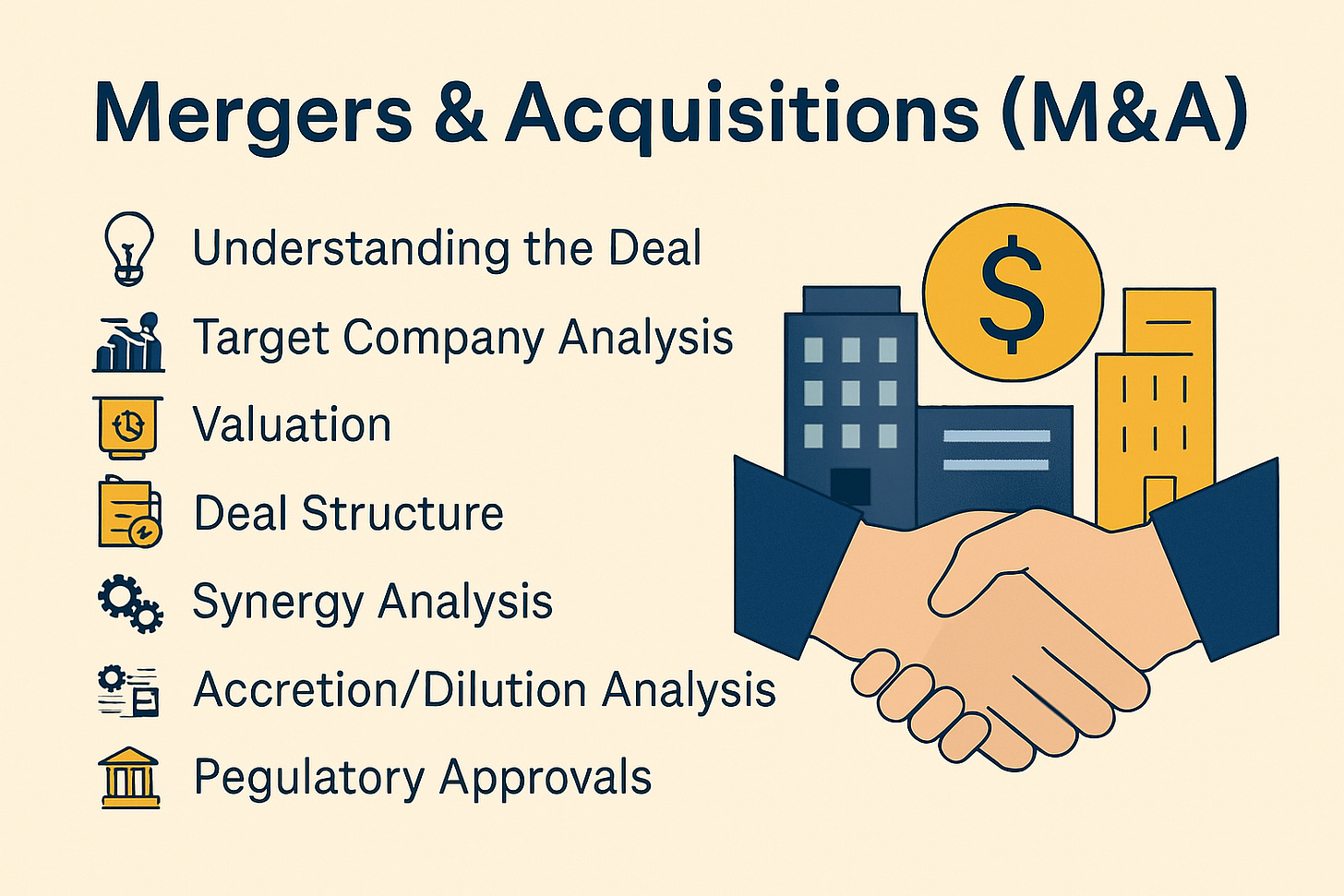Did you know 70% of M&A deals fail? Here’s why
Hi Readers,
Welcome to the another edition of The Valuation Story.
Mergers and Acquisitions (M&A) are among the most exciting events in the corporate world. These deals can create business empires, drive innovation, and completely reshape industries.
But how do they work?
Let’s break down the entire process in simple terms, step by step.
What is M&A?
Mergers & Acquisitions (M&A) refer to the process where one company buys, combines, or merges with another company. While both terms are often used interchangeably, they are different:
Merger: Two companies combine to form a new entity (e.g., Vodafone-Idea merger).
Acquisition: One company buys another and takes control (e.g., Facebook acquiring WhatsApp).
Companies go for M&A for several reasons: to expand, eliminate competition, enter new markets, or gain new technologies.
Step 1: Why Does a Company Want to Buy Another?
Before an M&A deal happens, the buyer must have a solid reason for acquiring another company. Some common reasons include:
Growth: Buying a company with an established presence can be faster than building new products or services from scratch.
Synergies: Two companies together can create more value than they would separately by reducing costs or increasing revenues.
Market Expansion: Entering a new geographical region or industry.
Competitive Advantage: Eliminating a competitor from the market.
Technology or Talent Acquisition: Gaining expertise, patents, or innovative products.
Financial Gains: Buying undervalued companies and selling them later at a higher price.
Example: When Tata Motors acquired Jaguar-Land Rover, it gained entry into the luxury car segment globally.
Step 2: Identifying the Right Target Company
Once a company decides to acquire, it must identify the right target company. This involves:
Industry Research: Finding potential companies in the desired sector.
Financial Analysis: Checking revenue, profit, and financial health.
Competitive Positioning: Is the target company a market leader or struggling?
Risks Assessment: Checking for potential risks like lawsuits, debt, or declining sales.
Example: Before Facebook acquired WhatsApp, it analyzed WhatsApp’s massive user base and potential for future revenue.
Step 3: How is the Target Company Valued?
The next step is to determine how much the target company is worth. There are three common ways to do this:
DCF (Discounted Cash Flow) Method: Estimates the company's future cash flows and discounts them to present value.
Comparable Companies (Comps) Method: Compares the target with similar public companies based on valuation multiples (e.g., EV/EBITDA, P/E Ratio).
Precedent Transactions Method: Look at past M&A deals in the same industry to find an appropriate price.
Example: If Reliance were to acquire Zomato, it would compare Zomato’s valuation with similar food-tech companies like Swiggy and DoorDash.
Step 4: Structuring the Deal (How Will the Payment Happen?)
Once the valuation is finalized, the acquirer decides how to pay for the deal. There are several ways to do this:
All-Cash Deal: The buyer pays the full amount in cash (e.g., Google’s $12.5B acquisition of Motorola).
Stock Swap: The buyer offers its shares in exchange for the target company’s shares (e.g., Zomato acquiring Blinkit).
Mixed Payment (Cash + Stock): A combination of cash and shares.
Leveraged Buyout (LBO): Using debt to acquire a company, common in private equity deals.
Each structure has different risks and benefits. Cash deals are straightforward, but stock swaps depend on share price fluctuations.
Step 5: Synergy Analysis – Will the Deal Create Value?
One of the most important reasons for an M&A deal is to achieve synergies. There are two types:
Cost Synergies: Reducing costs by eliminating duplicate operations.
Revenue Synergies: Increasing revenue by cross-selling products or entering new markets.
Example: After Disney acquired Marvel, it increased revenue through movie franchises, theme parks, and merchandise.
Step 6: Accretion/Dilution Analysis – Will the Deal Increase Profits?
After structuring the deal, the acquirer checks whether the deal will increase its earnings per share (EPS).
Accretive Deal: EPS increases (Good deal ✅).
Dilutive Deal: EPS decreases (Bad deal ❌).
Example: If Reliance acquires Tata Consumer and Tata’s earnings are higher than Reliance’s cost of acquisition, it’s an accretive deal. If not, it’s dilutive.
Step 7: Getting Regulatory Approvals
Big M&A deals require government approvals. The main regulatory bodies include:
SEBI (India) – Ensures shareholders' rights are protected.
CCI (Competition Commission of India) – Ensures no monopolies are created.
FTC (USA) – Checks anti-competitive behaviour in mergers.
Example: Walmart’s acquisition of Flipkart had to be approved by India’s Competition Commission (CCI) before going through.
Step 8: Post-Merger Integration – The Most Difficult Phase
Even after the deal is closed, the hard work continues. The two companies must now integrate their operations, which includes:
Merging company cultures and teams
Integrating IT, supply chains, and accounting systems
Achieving the expected synergies
Many M&A deals fail due to poor integration.
Example: Vodafone and Idea merged, but struggled post-merger due to high debt and competition from Jio.
Real-World M&A Examples
Facebook Acquiring WhatsApp ($19 Billion) – Facebook acquired WhatsApp for its user base and future monetization potential.
Disney Acquiring Marvel ($4 Billion) – A perfect synergy example where Disney expanded its superhero franchise massively.
Vodafone-Idea Merger – A struggling merger due to debt and tough market conditions.
Tata Motors Acquiring Jaguar-Land Rover – A successful acquisition that helped Tata enter the luxury car market.
M&A is not just about buying and selling companies. It’s a mix of strategy, valuation, execution, and integration. A well-planned M&A deal can create immense value, but if executed poorly, it can destroy billions.
Whether it’s startups looking for funding or billion-dollar corporations acquiring competitors, the fundamentals remain the same: Find the right target, value it correctly, structure the deal wisely, and integrate effectively.
What’s the best or worst M&A deal you’ve seen? Let’s discuss it!
Signing of'
The Valuation Story


